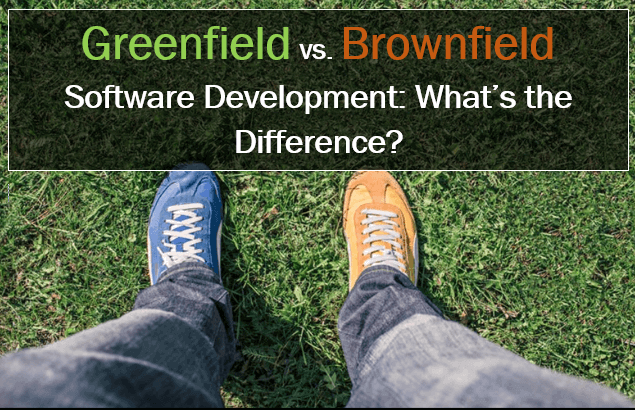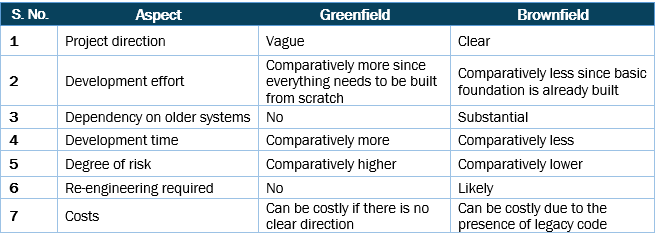Brownfield vs. Greenfield Development: What’s the Difference in Software?
With software becoming one of the fastest and most dynamic industries, it requires developers to use appropriate software development tools and methodologies in order to develop products that meet the growing demands of modern businesses. Greenfield and Brownfield software development are two approaches to developing cutting-edge software. So, what are these approaches? How are they different? Is Greenfield software development better for you, or should you consider a Brownfield project? Keep reading to find out the major differences between Brownfield and Greenfield projects.

Mục Lục
What is Greenfield Software Development?
Greenfield software development refers to developing a system for a totally new environment and requires development from a clean slate – no legacy code around. It is an approach used when you’re starting fresh and with no restrictions or dependencies.
A pure Greenfield project is quite rare these days, you frequently end up interacting or updating some amount of existing code or enabling integrations. Some examples of Greenfield software development include: building a website or app from scratch, setting up a new data center, or even implementing a new rules engine.
The Advantages of Greenfield Software Development
Some of the greatest advantages of Greenfield Software Development include:
- Gives an opportunity to implement a state-of-the-art technology solution from scratch
- Provides a clean slate for software development
- No compulsion to work within the constraints of existing systems or infrastructure
- No dependencies or ties to existing software, preconceived notions, or existing business processes
The Disadvantages of Greenfield Software Development
As with anything, there can be cons to taking on a Greenfield project. Greenfield application development disadvantages include:
- With no clear direction, the degree of risk is comparatively higher
- Since all aspects of the new system need to be defined, it can be quite time consuming
- With so many possible development options, there may be no clear understanding of the approach to take
- It may be hard to get everyone involved to make critical decisions in a decent time frame
What is Brownfield Software Development?
Brownfield software development refers to the development and deployment of a new software system in the presence of existing or legacy software systems. Brownfield application development usually happens when you want to develop or improve upon an existing application, and compels you to work with previously created code.
Therefore, any new software architecture must consider and coexist with systems already in place – so as to enhance existing functionality or capability. Examples of Brownfield development include: adding a new module to an existing enterprise system, integrating a new feature to software that was developed earlier, or upgrading code to enhance the functionality of an app.
The Advantages of Brownfield Software Development
Some of the largest advantages of Brownfield development include:
- Offers a place to start with a predetermined direction
- Gives a chance to add improvements to existing technology solutions
- Supports working with defined business processes and technology solutions
- Allows existing code to be reused to add new features
The Disadvantages of Brownfield Software Development
Brownfield projects do also have their own set of disadvantages. These include:
- Requires thorough knowledge of existing systems, services, and data on which the new system needs to be built
- There may be a need to re-engineer a large portion of the existing complex environment so that they make operational sense to the new business requirement
- Requires detailed and precise understanding of the constraints of the existing business and IT, so the new project does not fail
- Dealing with legacy code can not only slow down the development process but also add to overall development costs
Comparison Overview of Greenfield Development vs. Brownfield Development

Which is Better for You: A Greenfield Project or Brownfield Project?
Software lies at the core of every product or service. So, choosing the right development approach is vital to the success of your software. Since greenfield software development carries a higher degree of risk, agile practices are often deemed the best approach. By developing software in small iterations and getting them in the hands of customers for quick feedback, they help with efficient handling of risks.
On the other hand, Brownfield projects are often built on a more stable infrastructure with confirmed business processes; therefore, they are less prone to risk. However, a substantial proportion of development effort is spent on understanding and integrating with the existing business landscape rather than delivering value. With Brownfield development too, the best way to ensure success is by using an iterative approach to refine existing logical and physical architecture and accelerate development, improve product quality, and minimize defects.
Although no one approach is better than the other, depending on whether you want to develop a new product from scratch or improve the functionality of an existing product, you need to choose the right approach for the best outcome. No matter how you settle on a Brownfield or Greenfield development approach, ensure you’re keeping your organization’s greatest needs in mind every step of the way.
Contact Synoptek to learn how our software product development services can shorten product lifecycles by up to 40%.















![Toni Kroos là ai? [ sự thật về tiểu sử đầy đủ Toni Kroos ]](https://evbn.org/wp-content/uploads/New-Project-6635-1671934592.jpg)


